17
Mar
Study Shows the Benefits of Pesticide-free Pollinator Habitat
(Beyond Pesticides, March 17, 2015) Foraging bumblebees would prefer to dodge traffic rather than pesticides and other agricultural chemicals, according to the results of a new study published in the Journal of Insect Conservation. Researchers from Plymouth University in England discovered that the number of bumblebees observed foraging plants along roadsides was over twice the number located in adjacent patches facing agricultural crops. As both native and managed bees continue to decline throughout the globe, this research strengthens calls from farming and environmental groups to improve agricultural practices through increased on-farm diversity, and sharp reductions in the use of pesticides, particularly systemic chemicals such as neonicotinoids.
 Mick Hanley, Ph.D., lead author of the study, explains, “There have been hedgerows and field boundaries in these locations for centuries, and even if you go back 50 or 60 years, you would not have seen this phenomenon. Both sides of hedgerows would have been flourishing, and bees and other insects would have been numerous on both sides, but that was before an increase in the use of fertilizers.”
Mick Hanley, Ph.D., lead author of the study, explains, “There have been hedgerows and field boundaries in these locations for centuries, and even if you go back 50 or 60 years, you would not have seen this phenomenon. Both sides of hedgerows would have been flourishing, and bees and other insects would have been numerous on both sides, but that was before an increase in the use of fertilizers.”
However, it is likely the use of agrichemicals that has caused such a stark discrepancy between roadside and farm-side habitats. “Now what you see is the chemicals having impacted one side, with the hedgerows in effect acting as a filter to protect the road-facing edge. It decreases the bees’ sources of food and, therefore, has the potential to impact on their numbers,” Dr. Hanley explains.
Researchers reach the conclusion in the study that organic farming is likely to offer distinct advantages for pollinator conservation efforts. As a result of reduced chemical use, organic farms are likely to provide pollinators with a greater diversity of flowers, and thus increase food availability. “The pesticides and fertilisers in use today tend to mean plants such as nettles flourish, whereas honeysuckle and other bee-friendly species do not,” said Dr. Hanley. “But we would argue that if farmers were a bit more sympathetic, any work they do to encourage bees and other insects could have reciprocal benefits for them and their crops.”
In the United States, efforts to increase pesticide-free pollinator habitat are under attack by industry. Last week trade groups AmericanHort and the Society of American Florists rejected an important, positive component of President Obama’s White House Pollinator Task Force recommendations. The groups called guidelines from the White House Council on Environmental Quality (CEQ) to increase neonicotinoid-free pollinator friendly habitat at federal facilities “largely unachievable,” despite widespread demand for an urgent need to transition away from bee-toxic pesticides.
Although announced without mention of pesticides, the U.S. Department of Agriculture indicated it would provide $4 million in technical and financial assistance to U.S. farmers and ranchers in the Midwest to improve honey bee health. The new research suggests that, in addition to habitat, regulators efforts are needed to reduce the on-farm use of pesticides.
Beyond Pesticides maintains that pesticide-free hedgerows are a critical part of the solution to global pollinator declines. By taking advantage of the “edge effect,” an area where two environments/ecosystems meet, hedgerows can provide high levels of biodiversity. However, as this study shows, farmers and land managers must take pesticides out of the equation in order to realize the full benefits that hedgerows can provide.
For more information on the benefits of hedgerows, and guidelines to get your started, read Beyond Pesticides recent article by Terry Shistar, Ph.D., “Hedgerows for Biodiversity,” You can also work on creating your own pesticide-free pollinator habitat by visiting the BEE Protective webpage, “Managing Landscapes with Pollinators in Mind.” The BEE Protective Habitat Guide will help you decide which plants work for your region and the type of pollinators you want to attract. Join us in continuing to put pressure on the White House to take swift action to reverse bee declines by signing the petition to President Obama at save-bees.org.
And join us in person to help us continue the fight to protect pollinators! This spring is Beyond Pesticides’ 33rd National Pesticide Forum in Orlando, FL, April 17-18th 2015. Register today!
All unattributed positions and opinions in this piece are those of Beyond Pesticides.
Source: Plymouth Herald, Journal of Insectology










